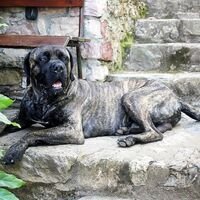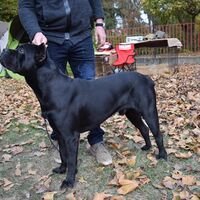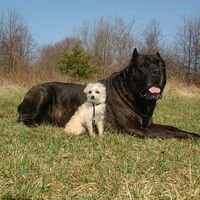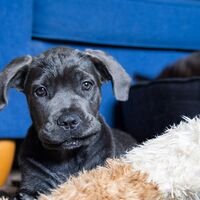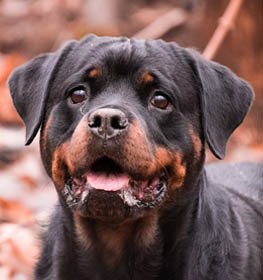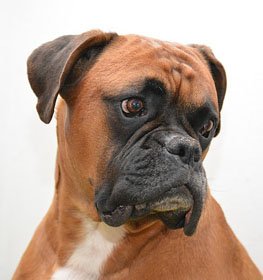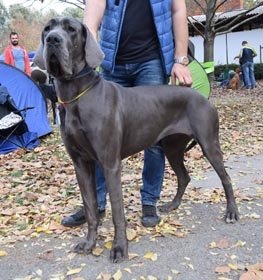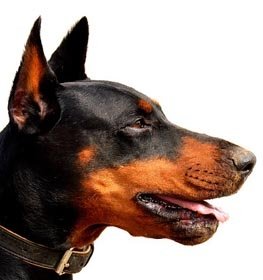Cane Corso Information & Dog Breed Facts
Collection of all the general dog breed info about Cane Corso so you can get to know the breed more.
| Group | Working Dogs |
|---|---|
| Popularity Rank | 37 |
| Reviews | 6 |
| User Ratings | |
|
Compare the Cane Corso With Other Dogs
Select at least one dog breed to make the comparsion. | |
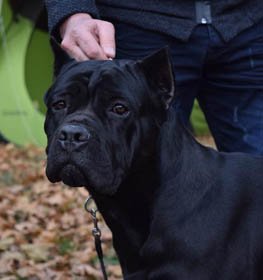 | |
| Origin | |
|
Common Names & Aliases
What other names is a Cane Corso known by? Discover all traditional, regional and informal names used for this breed. | Cane Di MacellaioCane Corz |
|---|---|
|
Breed Classification
What type of dog breed is a Cane Corso? Learn about its genetic classification and breeding category. | Purebred The Cane Corso is considered a purebred dog breed, but many mixes and hybrids have been created from this breed. We have compiled a list of Cane Corso Mixes. |
Photo Gallery of the Cane Corso Breed
|
Size Classification
What size category is a Cane Corso? Learn how big the Cane Corso breed typically grows. | Large |
|---|---|
|
Weight Statistics
How much does a Cane Corso weigh? Discover typical weight ranges for adult males and females of the Cane Corso breed. | Male: 99-110 pounds (45-50 kg), Female: 88-99 pounds (40-45 kg) |
|
Average Weight
What is the average weight of a Cane Corso? | Male: 104.5 pounds (47.5 kg), Female: 93.5 pounds (42.5 kg) |
|
Height
How tall is the Cane Corso? Cane Corso height: | Male: 24-27 inches (64-68 cm), Female: 23-25 inches (60-64 cm) |
|
Average Height
What is the average height of a Cane Corso? | Male: 25.5 inches (66 cm), Female: 24 inches (62 cm) |
|
Price Range
How much does a Cane Corso puppy cost? Find current market prices and factors affecting Cane Corso costs. | $1500-$2000 If you choose to purchase the Cane Corso, you should know that the mentioned amount of money is an average of the collected data from breeders’ sites and puppy finder places. If you have a Cane Corso for sale, please advertise it on a reliable website to make sure the Cane Corso gets to a happy place. |
|---|---|
|
Availability
How easy is it to get a Cane Corso? How many Cane Corso are there in the world? | Very frequent: The Cane Corso is quite easy to get. There is a risk of overbreeding, as it is an extremely popular breed. Inbreeding is common because of its popularity. A new study suggests that inbreeding contributes to the incidence of disease and health problems. So be careful, buy from a trustworthy place or kennel and seek the help of an experienced person, a professional, to make the right decision. |
|
Intelligence Rating
How intelligent is a Cane Corso? Discover the Cane Corso's intelligence ranking and learning capabilities. | Smart: The Cane Corso dogs have great intelligence. They understand and memorize new commands in 15-25 repetitions.
The Cane Corso is among the smartest dogs in the intelligence ranking. |
|---|---|
|
Training Difficulty
How easy is it to train a Cane Corso? Learn about the Cane Corso's trainability and response to training methods. | Cane Corso dogs are easy to train. They find out the association between commands and actions quite quickly. |
|
Watchdog Rating
How good is a Cane Corso as a watchdog? Learn about the Cane Corso's alertness and guarding instincts. | Cane Corso dogs are one of the best watchdogs. Their main job is to observe and they're very consistent in their effort. The best vocal cords and sense of hearing belong to them. Usually, they're very territorial and protective about their property, so the Cane Corso dogs will alert you if they sense something different. |
|
Territorial Protection
Is a Cane Corso protective of its territory? Learn about the Cane Corso's guarding instincts and behavior. | Cane Corso dogs are extremely protective guard dogs. This breed doesn't hesitate to protect its territory so the Cane Corso can be a good choice if you want an excellent guard dog. Keep calm and the Cane Corso will take care of unwanted people or animals. |
|
Personality Traits
What personality does a Cane Corso have? Learn about characteristic Cane Corso temperament and behavior traits. | CourageousLoyalSocialCheerfulQuiet |
|---|---|
|
Sensitivity Level
How sensitive are they? Cane Corso sensitivity: | Cane Corso dogs have an average emotional level and are not the most sensitive dog breed. Sometimes it's okay to change the daily routine, have guests and listen to loud music.
Some dogs handle moderate punishment very well, while others crumble apart at a dirty look. This breed is not affected emotionally by moderate punishment. |
|
Affection Level
How affectionate are they? Is a Cane Corso a good family dog? | Average: Cane Corso dogs are average dogs regarding their affection level. Some breeds are forthcoming and friendly, while others are independent and don't bond too closely with their owners. |
|
Social Needs
How much social interaction does the Cane Di Macellaio need? Cane Corso social needs: | Cane Corso dogs are a social breed. They enjoy being around people or other animals. This breed doesn't tolerate being left alone. |
|
Impulse to Wander or Roam
How likely is the Cane Corso to run away? Does this breed explore or wander a lot? Does Cane Corso roam? | Cane Corso dogs tend to escape less than other breeds. They have low to average wanderlust potential. Exploring the world is not the best activity they can imagine. |
|
Prey Drive
Do this canine have a strong prey drive? Does Cane Corso have high prey drive? | Cane Corso dogs have a high impulse to chase and catch something. Cats or any other small animals are in danger. It's a natural instinct, doesn't necessarily mean that Cane Corso dogs are aggressive. Better to keep this breed on a leash. |
|
Barking Frequency
Does a Cane Corso bark a lot? Learn about typical Cane Corso vocalization patterns and triggers. | Low: The Cane Corso barks none to minimal. Perfect choice if you prefer a quiet breed.
Top reasons for barking: protection, alarm, fear, boredom, attention-seeking, greeting, separation anxiety, compulsive barking. |
|---|---|
|
Playful Nature
How playful is a Cane Corso? Understand the typical play drive and energy level of the Cane Corso breed. | Average: Cane Corsos, like any other dog breed, like playing. Sometimes they bark in excitement for playing, but they are not the most playful dog breed. |
|
Apartment Adaptability
Can a Cane Corso live in an apartment? Learn about the Cane Corso's suitability for apartment living. | It is not recommended to keep the Cane Corso breed in the home. It does best in the garden, but if you do want to keep it indoors, it should be exercised thoroughly with long daily walks, so you can keep the Cane Corso indoors by introducing daily routines. |
|
Lifestyle Adaptability
How adaptable is a Cane Corso to lifestyle changes? Learn about the Cane Corso's flexibility to new situations. | Cane Corso dogs don't adapt well to lifestyle changes and different living environments. They don't like moving from one place to another. |
|---|---|
|
Alone Time Tolerance
Can a Cane Corso be left alone? Learn about the Cane Corso's tolerance to solitude. | Cane Corso dogs do best when a family member is at home during the day or if their workplace is dog-friendly so they can take the dog at work. |
|
Bite Risk Assessment
What is a Cane Corso biting potential? Learn about the Cane Corso's bite risk factors. | Moderate ⏺ The Cane Corso has an average chance of biting somebody. Top reasons for dog bite: protection, pain, excitement, herding instinct, being provoked. (Data based on the available online bite statistics.) |
|---|---|
|
Mouthing Tendency
Is a Cane Corso mouthy? Learn about the Cane Corso's tendency to use mouth during play. | Cane Corso dogs have a higher than average tendency to nip, chew, playbite, or herd people. It's a common habit during puppyhood, not aggressive behavior. These "bites" don't hurt, but Cane Corso dogs need to be taught a good attitude. |
|
Bite Strength Rating
How strong is a Cane Corso bite? Learn about the Cane Corso's bite force measured in PSI. | Above 400 PSI 🔼 Cane Corso bite force: The Strongest. The Cane Corso bite force is among the strongest in the canine world. The bite force Cane Corso measurements are typically quite high, which is a testament to their powerful and large stature. The bite force of Cane Corso dogs is impressive, and their Cane Corso bite PSI is reflective of their powerful nature.
The Cane Corso PSI bite should be respected, and appropriate precautions should be taken when interacting with these dogs. The PSI of a Cane Corso bite is high, making them one of the strongest breeds in terms of bite force. They are very protective of themselves and their families, therefore a dog bite from them could be exceptionally dangerous with their PSI being above 400. To ensure a well-behaved and controlled dog, it's important to learn how to train a Cane Corso puppy not to bite from an early age. It is important that they’re trained to be around others safely. |
|
Average Lifespan
How long does a Cane Corso live? Learn about the typical lifespan of the Cane Corso breed. | 10-12 years The average lifespan of Cane Corso: 11 years |
|---|---|
|
Climate Tolerance
How well does a Cane Corso handle different weather? Learn about the Cane Corso's climate adaptability. | Tolerates warm and cold weather Dogs that tolerate hot and cold weather are typically those that have a double coat of fur. Dogs with a double coat of fur have a layer of fur that insulates their skin and helps protect them from the cold and the heat. |
|
Health Concerns
What health issues are common in a Cane Corso? Discover typical conditions affecting the Cane Corso breed. | Cane Corsos are commonly healthy dogs. Vet costs aren't expensive with this breed. |
|
Vet Care Frequency
How often does a Cane Corso need vet visits? Learn about the Cane Corso's veterinary care requirements. | Rare The Cane Corso should have a complete physical check-up at least every 12-18 months (but preferably once per year). If your dog shows any symptoms, call your veterinarian. |
|
Health Problems
What genetic/health problems does the Cane Corso breed have? What are the health issues and concerns of the Cane Corso breed? Most common health risks of Cane Corso: | Hip Dysplasia BloatEntropionCherry EyeEctropionArthritisDemodectic Mange |
|
Energy Rating
How energetic is a Cane Corso? Understand daily activity needs of the Cane Corso breed. | Cane Corso dogs have a higher energy level than other dog breeds. If you want a dog for snuggling on the couch, this breed isn't the perfect choice for you. |
|---|---|
|
Activity Requirement / Exercise Need
How much exercise does a Cane Corso need? How much exercise do Cane Corso dogs require per day?
Do Cane Corso dogs need a lot of exercises? | Cane Corso dogs have an average exercise need. This breed is satisfied with short walks every weekday and a long ones on weekends. |
|
Sleeping Need
How much sleep does the Cane Corso breed need? | Cane Corso dogs are quite energetic dogs and they don't spend too much time with sleeping. If you live an active life, this breed can be a good choice for you. |
|
Obesity Tendency
Is a Cane Corso prone to weight gain? Learn about the Cane Corso's obesity risks. | Average to High: If you don't pay attention to the Cane Corso's weight, he can easily gain weight. More than one daily walk should be on schedule. To make your dog happy and fit, feed him with quality dry dog food and live an active life together. Try to find the happy medium between exercise and feeding.
If you notice any weight gain, consult your veterinarian and make a diet plan. Reduce unhealthy food and snacks, and measure the Cane Corso weight regularly. |
|---|---|
|
Food Consumption
How much food does a Cane Corso need daily? Learn about the Cane Corso's feeding requirements. | Recommended daily amount: If you are feeding a high-quality dry food, your Corso will probably eat 4 to 5 cups a day. |
|
Allergy Friendliness
Is a Cane Corso hypoallergenic? Learn about the Cane Corso's suitability for allergy sufferers. | No Cane Corso dogs don't do well with allergy sufferers by causing allergic reactions. Some dog breeds are even considered to higher possibility of an allergic response. Coat type isn't necessarily relevant, because most people are allergic to dander (flakes on the dog's skin) or saliva, not actually to dog hair. |
|---|---|
|
Coat Colors
What colors does a Cane Corso come in? Discover all possible Cane Corso color variations. | BlackGray Red Fawn Brindle Chestnut |
|
Grooming Requirements
How much grooming does a Cane Corso need? Learn about Cane Corso coat maintenance requirements. | Effortless: The Cane Corso requires minimal grooming. Seasonal flea treatment is needed, but cutting the dog's hair by a professional groomer isn't necessary. Ears and eyes should be cleaned sometimes to avoid infections. Cane Corso is one of the best choices if you don't have the time, skill, or money to take care of a high-maintenance dog. Highly recommended for beginners. |
|
Drooling Tendency
Does a Cane Corso drool a lot? Learn about the Cane Corso's drooling habits. | The Cane Corso drools quite a lot, so if you dislike being covered by slobber spots on your clothes, you may want to choose another dog breed. Drooling is the unintentional saliva flowing outside of the mouth. It can be completely normal or a sign of a health problem. Certain dog breeds drool more than others, just like the Cane Corso.
If you notice any change in your dog's drooling habit, you should contact a vet as soon as possible. |
|
Stinkiness Rating
Does a Cane Corso smell bad? Learn about the Cane Corso's natural odor levels. | Medium ⏺ The Cane Corso has an average chance of bad smell. Top reasons for dog stinkiness: infection of bad tooth/ear/skin folds, gas attacks. |
|
Coat Characteristics
What type of coat does a Cane Corso have? Learn about the Cane Corso's fur characteristics. | Dense |
|
Bathing Needs
How often does a Cane Corso need baths? Learn about the Cane Corso's bathing requirements. | 4-6 weeks Average. Experts recommended at least every 4-6 weeks for this family pup. According to a study, 56% of pet parents don’t bathe their dogs as frequently as they should, and 60% use the sniff test when deciding when it’s bath time.
Bathing your dog is beneficial to them in more ways than just one. It’s also a good time to look for unusual scratches, bumps, fleas, and other irregularities. When their hair is wet and flat against their body, these details are more visible. |
|
Shedding Level
How much do Cane Corso dogs shed? How to control, reduce and prevent the shedding of the Cane Di Macellaio? Do Cane Corso dogs shed a lot? | Cane Corso dogs shed moderately. It's a natural process of the hair growth cycle. Regular brushing reduces the amount of hair that sheds. It mostly depends on their health status and breed type. |
|
Child Compatibility
Is a Cane Corso good with children? Learn about the Cane Corso's behavior around kids of different ages. | Cane Corso dogs are average friendly dogs towards children. |
|---|---|
|
Pet Compatibility
How well does a Cane Corso get along with other pets? Discover the Cane Corso's compatibility with other animals. | Cane Corso dogs do best when they’re the only pet at the family. |
|
Stranger Friendly
Are they aggressive or friendly towards/with strangers? Cane Corso temperament with other people: | Cane Corso dogs are not stranger friendly dogs. |
|
Cat Friendly
How well do Cane Corso dogs get along with cats? Are they good with kittens? What is this fido's temperament with cats? Can they be good with cats? Can the Cane Corso breed live with a cat? | Cane Corso dogs are not cat-friendly dogs. |
|
Dog Friendly
Is Cane Corso good with other dogs? Are they dog-friendly dogs? How well do Cane Corso dogs get along with other dogs? | Cane Corso dogs are average friendly towards other dogs. |
|
Good For First Time Owners
Is Cane Corso breed good for first-time owners? Do they make a good dog for novice owners? Is Cane Corso breed suitable for first-time owners? | No Cane Corso dogs are not good for novice owners, due to their stubborn personality. |
|
Office Friendly
Are Cane Corso dogs good office canines? Do Cane Corso dogs make good office-friendly pets? Can they be office dogs? | No Cane Corso is not the best dog breed for office environment. |
|
Senior Citizens Friendly
Are they senior citizens friendly dogs? How well do Cane Corso dogs get along with the elderly people? What is the Cane Di Macellaio temperament with senior people? Are Cane Corso dogs good for elderly owners? | Cane Corsos are commonly okay with elderly people. |
|
Service Dog Capability
Can a Cane Corso be a service dog? Learn about the Cane Corso's service work potential. | Yes This breed makes good as a service dog. A service dog is a term used in the USA to refer to any type of assistance dog specifically trained to help people who have disabilities, such as visual impairment, hearing impairments, mental disorders, seizures, mobility impairment, and diabetes. Service dogs are protected under the ADA (Americans with Disabilities Act).
Cane Corso breed is a good choice for service purposes. |
|---|---|
|
Therapy Work Suitability
Is a Cane Corso good as a therapy dog? Learn about the Cane Corso's therapy work aptitude. | Not really This breed is generally not used as a therapy dog. A therapy dog is a dog that might be trained to provide affection, comfort, and love to people in hospitals, retirement homes, nursing homes, schools, hospices, disaster areas, and people with anxiety disorders or autism.
Cane Corso is not the best breed for therapeutic purposes. |
|
Scent Detection Ability
Is a Cane Corso good at detection work? Learn about the Cane Corso's scenting abilities. | Not really They are not typically employed for this type of work, but there may be exceptional cases. A detection dog or sniffer dog is a dog that is trained to use its senses (mostly its smell) to detect substances such as explosives, illegal drugs, wildlife scat, currency, blood, and contraband electronics such as illicit mobile phones.
Cane Corso is not the best breed for detection purposes. |
|
Search & Rescue Potential
Can a Cane Corso do search and rescue? Learn about the Cane Corso's SAR capabilities. | Not really This dog breed is not typically used as a search and rescue dog. The use of dogs in search and rescue (SAR) is a valuable component in wilderness tracking, natural disasters, mass casualty events, and locating missing people.
The Cane Corso is not the best breed for SAR purposes. |
|
Maritime Work Ability
Is a Cane Corso good on boats? Learn about the Cane Corso's maritime capabilities. | Not really Cane Corso breed usually doesn't like being on a boat. Boat dogs were typically bred for their strength, stamina, and water resistance, as they were often required to perform tasks such as pulling in fishing nets, and jumping into the water to retrieve ropes or lines, or helping to move cargo. Sailor dog is a type of dog that was bred to accompany sailors on their voyages. They were typically used for three purposes: as a working dog, a watchdog, and as a companion. A boat dog is a term used to describe a type of dog that was traditionally bred and used as a working dog on boats. |
|
Draft Work Capability
Can a Cane Corso pull carts? Learn about the Cane Corso's drafting abilities. | Yes A drafting dog or draft dog is a dog bred and used for cart pulling. Dogs bred for this work have strong builds and qualities that are needed, strength and determination.
Cane Corso breed is a good choice for drafting purposes. |
|
Military Service Background
Was a Cane Corso used in military service? Learn about the Cane Corso's military history. | Yes In history, this breed was unfortunately used for combat dogs. A combat dog is a specially trained dog that is used in warfare to help protect military personnel and assets. Combat dogs are often deployed in areas where there is potential for contact with the enemy, such as during raids or search operations.
Combat dogs are typically assigned to either infantry or special operations units. They are used for a variety of tasks including area security, sentry duty, trackers, and explosive detection. In addition to their combat roles, combat dogs also play an important role in troop morale by providing companionship and emotional support. |
|
Puppy Litter Size
How many puppies does a Cane Corso usually have? Learn about typical litter sizes. | 4-6 puppies |
|---|---|
|
Pregnancy Duration
How long is a Cane Corso pregnant? Learn about the Cane Corso's gestation period. | 60-64 days Reproductive cycle of the female Cane Corso: The first period called Proestrus lasts for about 9 days.
During this time the females start to attract males. You can notice by swelling vulva and bloody discharge. The second part is the Estrus when the female is receptive for the male. It lasts for about 3 to 11 days. The sign of the proestrus part is the soft and enlarged vulva. The discharge decreases and lightens in color. The third part is the Diestrus. Normally, it occurs around day 14. In this period the female’s discharge changes for vivid red and coming to its end. The vulva returns to average, and she will no longer permit mating. The fourth part called the Anestrus. The time frame between heat periods normally lasts about six months. |
|
Breeding Frequency
How often can a Cane Corso have puppies? Learn about safe breeding intervals. | Once a year. More frequent breeding is not healthy. It is very important not to buy a dog from a puppy mill, where the needs of the pups and their mothers are ignored. It's an inhumane high-volume dog breeding facility, where puppies born several times a year. |
|
AKC Classification
What AKC group is a Cane Corso in? Learn about the Cane Corso's AKC classification. | Recognized by the American Kennel Club in 2010 as a Working breed. |
|---|---|
|
FCI Classification
What FCI group is a Cane Corso in? Learn about the Cane Corso's international classification. | Recognized by FCI in the Pinscher and Schnauzer - Molossoid and Swiss Mountain and Cattledogs group, in the Molossian type section. |
|
Kennel Club Recognition
Which kennel clubs recognize a Cane Corso? Learn about the Cane Corso's official recognition. | American Canine RegistryAmerican Kennel ClubAmerica's Pet RegistryDog Registry of America Inc.Federation Cynologique InternationaleNorth American Purebred Registry, Inc.American Canine Association, Inc.National Kennel Club |
Cane Corso Pros and Cons
- Intelligence Rating: Smart: The Cane Corso dogs have great intelligence.
- Training Difficulty: Cane Corso dogs are easy to train.
- Health Concerns: Cane Corsos are commonly healthy dogs.
- Grooming Requirements: Effortless: The Cane Corso requires minimal grooming.
- Watchdog Rating: Cane Corso dogs are one of the best watchdogs.
- Impulse to Wander or Roam: Cane Corso dogs tend to escape less than other breeds.
- Service Dog Capability: This breed makes good as a service dog.
- Draft Work Capability: A drafting dog or draft dog is a dog bred and used for cart pulling.
- Allergy Friendliness: Cane Corso dogs don't do well with allergy sufferers by causing allergic reactions.
- Apartment Adaptability: It is not recommended to keep the Cane Corso breed in the home.
- Drooling Tendency: The Cane Corso drools quite a lot, so if you dislike being covered by slobber spots on your clothes, you may want to choose another dog breed.
- Obesity Tendency: Average to High: If you don't pay attention to the Cane Corso's weight, he can easily gain weight.
- Mouthing Tendency: Cane Corso dogs have a higher than average tendency to nip, chew, playbite, or herd people.
- Lifestyle Adaptability: Cane Corso dogs don't adapt well to lifestyle changes and different living environments.
- Alone Time Tolerance: Cane Corso dogs do best when a family member is at home during the day or if their workplace is dog-friendly so they can take the dog at work.
- Cat Friendly: Cane Corso dogs are not cat-friendly dogs.
- Office Friendly: Cane Corso is not the best dog breed for office environment.
- Good For First Time Owners: Cane Corso dogs are not good for novice owners, due to their stubborn personality.
Cane Corso History
The Italian Molossian dog's origin goes back to time immemorial that neither history nor archaeology can give univocal certainty but what we know for sure is that when we talk about Italian Cane Corso, at the same time we also mean the Neapolitan Mastiff because (at least this is certain) they share the same genetic heritage. We also know about its word history. They used to call the Cane Corso: massatinus, in Italy that means guardian of the farm; cohors, that means double meaning courtyards dog and cohort dog at the same time. According to some theories, the Italian dog Cane Corso comes from the big Molossian dogs common among middle east populations: Assyrian, Babylonians, Greeks of Epirus, and was imported in Europe by Phoenician people, who used these kinds of dogs as guardian and as a commodity. In addition to these dogs already living in the italic peninsula, other kinds of dogs were added by Romans who brought them after the military campaign in Gallia: so, Romans crossbreed their Molossian dogs and Celtic dogs.
Ancient Romans had a very strong interest in fighting dogs and their breeding, because of two purposes: Firstly for warfare and hunting, and secondly for the circus, where they did fight against bears, lions, and tiger. In fact, perhaps during the Britain military campaign, they did create the figure of “procurator cynegii”, a special kind of officer who had to choose and to crossbreed different bloodlines so as to “create“ the most suitable dogs for these activities. “Tauromachy” was a common custom of the time, which still exists in Spain. At a Tauromachy there is a group of dogs (made by four dogs) or even of only one dog, and their aim is/was to immobilize a bull and tackling it by the ear or by the muzzle, two very sensitive points, so as to keep the bull fixed because of the big pain. But the most important purpose of using dogs was the war. Using warfare dogs has lasted for centuries in some different ways: by Spanish conquistadors so as to kill as many South American Indians as possible and, more recently, by the Italian army, during the italic Turkish war (1912), when some subjects of "Dogo Sardo" became involved in the war.
After the fall of the Roman Empire, only a few lords, who were landowners and often cattle farmers, could afford to have these kinds of dogs; in fact, they did need them and were able to keep them. According to needs, these dogs were crossbred with greyhound dog or hunting dog or tough sheepdog "canis pastoralis" in order to obtain a more dreadful shepherd dog.
Among the few people who could afford to keep heavy bloodline dogs, there were butchers, who used to take advantage of dogs so as to keep fixed bulls during the catch and during the killing; this is a custom that has been lasted until the first decades of the 20th century, getting a spectacular appearance, which is the heritage of the ancestral Tauromachy. Another way of using this breed was as a caretaker of pigs, sheep, and sometimes as a shepherd, in any case as guardian and even as "bodyguard dog" so as to dissuade the spiteful persons.
The preservation of this “dog population” (the idea of the breed spread only in the 19th century) has been carried on mostly in the south of Italy by people who used working dogs (farmers, hunters, lords, landowners, soldiers, gangsters) who seemed to be the last keepers of this cynognostic genetic heritage.
In 1949 was officially recognized the breed status; at the beginning, the breed was called “Mastino Napolitano Cane Corso cane da presa” that was changed in “Mastino Napoletano” because of the pressure exerted by Napoli's breeders who claim the right to name the breed saying that only thanks to them the breed could be kept. Sadly, this is a breed artificially kept by now. (In fact, the breeders often rely on artificial insemination, there are often cesarean sections and the breeders choose to bottle feed the puppies or sometimes they use another female dog that wet nurse the puppies on behalf of the mother. In any case, the natural mother of the puppies cannot feed them because after long years of artificial breeding these bitches have no more maternal instinct.) They are usually between 40 and 70 kg and their hair, usually is short, but not shaven and made up of coat and undercoat which is particularly thick during the winter. The range of coloration is larger than that is provided for by the standard and consists of plenty of colors.
Latest Cane Corso Compares
Cane Corso Names
How old is my Cane Corso in human years?
You May Also Like
Rate The Cane Corso Breed
Cane Corso Comments, Reviews and Questions
- ItzVdogs!
Apr 30, 2023, 7:28:21 PM:
I am not the biggest fan. They are very nicely tempered when puppies, but they become bullies when grown up
- Alex
Aug 14, 2022, 6:56:17 AM:
With socialization & professional training they are amazing. Mine are great with other dogs, all animals, & children. Brave, loyal, loving, & devoted. Bite force is 750PSI, DO NOT buy if you won’t invest in training. Responsibly bred cost $2500-3000.
- Thisas
Apr 26, 2022, 12:01:44 AM:
- Nia
Mar 16, 2022, 9:08:32 AM:
- Plm
Jan 5, 2020, 10:30:04 PM:
Total bullshit !
- Dave Hamilton
Dec 13, 2019, 7:38:28 AM:
If I had to stand behind any dog it would be a Cane Corso I guarantee no one is getting to you past him

